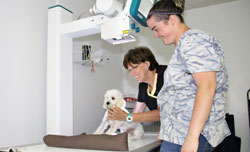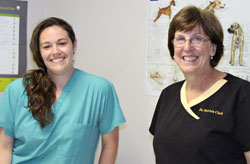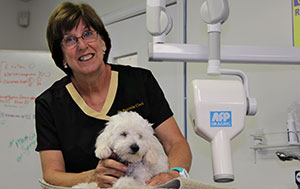Services
Click on any service to find out more about what we can do.
Preventive Care Services

German Flatts Veterinary Clinic provides comprehensive physical examinations along with the following to keep your pet healthy:
- Vaccinations
- Fecal parasite evaluation
- Heartworm & Lyme disease testing& prevention
- Feline leukemia and AIDS testing
- Diagnostic blood evaluation
- Up-to-date client education for pet health, diet, behavior and zoonotic diseases
X-Ray
Many people are familiar with radiographs (x-rays) through personal experience. It is also a very common procedure done in pets to diagnose problems such as broken bones, masses (tumors), obstructions, bladder stones, or hip dysplasia.

Our x-rays are taken and developed in house for diagnostic use.
OFA (Orthopedic Foundation for Animals) x-rays offer to evaluate hip dysplasia and provide information to a national database for control of hip dysplasia through selective breeding.
EKG
An electrocardiogram (EKG or ECG) is a diagnostic test that records the electrical activity of the dog's heart. It is a noninvasive test whiich is most commonly used for diagnosis of abnormal heart rhythms and can be useful for identification of heart enlargement or drug effects on your pet's heart.
Your pet's heart's activity is recorded by attaching small contact electrodes to their limbs and chest wall. This allows recording of electrical activity to be outputted from an electrocardiograph machine for evaluation.
Surgery

Pre-anesthetic blood testing.
Check internal organ function to minimize risk of anesthesia. Done in house the morning of the surgery.
Anesthetic monitoring of all surgical patients
Intravenous catheterization. Blood pressure. Blood oxygen saturation. Body temperature maintenance with warm water blanket.

Although we perform most general surgical procedure at our hospital, we are also able to provide referrals to board certified orthopedic or specialized surgeons should the need arise.
Super Wellness
Pets age much faster than we do. One year between exams for people is equal to SEVEN years between exams for your pet.

All dogs and cats should have a comprehensive physical examination EVERY 6 MONTHS to detect emerging health problems early to help ensure they live long, healthy, happy lives! Routine blood work is recommended yearly as a diagnostic tool to aide the veterinarian in diagnosing many diseases. Early intervention is the best course for extending healthy lives.
Dental Care
For most of us, caring for our teeth and gums has been part of our daily routine for as long as we can remember. Just like you, your pet needs dental care too - regular, professional care from us and effective daily brushing by you at home to keep your pet healthy.

We can provide: Ultrasonic scaling, polishing & fluoride treatment (extractions if warranted) under Sevoflo anesthesia. We provide dental x-rays! Hill's prescription diet available to prevent tartar and plaque build-up after dental procedure. Selection of pet safe toothbrush and toothpaste available.
It is more than bad breath... dental care can add three to five years to your pet's life. Dental care is a little recognized, yet necessary part of caring for your pets. By the age of three, some 80 percent of all dogs and 70 percent of all cats show signs of dental disease, which can lead to the more serious problems of heart, lung, and kidney disease. Dog breath and tuna breath aren't something to be ignored, for they are likely indicative of an oral problem. The sooner you have it treated by your veterinarian (and learn to care for it yourself), the sooner your pet can stay on the road to health as well as smell good! Periodontal disease is an infection of the gum tissue by bacteria. It all begins with Plaque! Plaque and tartar form naturally when food remains in the cracks of the teeth, especially at the gum line. Canned food sticks easier, so it is more likely to cause plaque. At this stage the plaque is still soft, and brushing or chewing hard food and toys can remove it. If it is left to spread, plaque can lead to gingivitis, an inflammation of the gums, causing them to become red and swollen and painful. Plaque soon hardens into tartar that forms a wedge separating the tooth from the gum. If the plaque and tartar buildup continue, pus can form at the root of the tooth. This is the most advanced stage, showing up as loose teeth, bleeding gums and pain anytime your pet tries to eat. Periodontal disease can be prevented and treated. The keys to your pet's oral health are professional veterinary dental care and good care at home. Too few pets receive both and most don't receive either. You can change that today!

Visit Us.
In addition to a physical examination and medical history, our doctors will examine your pet's teeth and gums. Recommendations may be made for cleaning, polishing, and other dental care in the hospital, or your veterinarian may suggest a program of home dental care. No other procedure performed on small animals does more to help patients than periodic teeth cleaning and after care. The dental visit for cleaning must be performed in a methodical manner. All steps are important and interlinked. When one step is not performed, long term patient benefit suffers. Presurgical blood work. These blood tests evaluate the blood cell count, liver and kidney function. THey determine which anesthetic protocol we use. IV Fluids. These help maintain your pet's blood pressure during anesthesia, provide IV access in the event of an emergency, and help metabolize the anesthesia. General anesthesia and monitoring by an animal health technologist. We carefully monitor every pet under anesthesia. We use a pulse oximeter to evaluate heart rate and oxygen saturation, and a doppler to evaluate any changes in blood pressure. Oral examination under general anesthesia. We examine individual teeth for mobility, fractures, malocclusion, and periodontal disease (probe for pocket depths after calculus is removed). Plaque and tartar removal using calculus removing forceps, hand instruments, and power scaling equipment.The ultrasonic scaler removes plaque and tartar from the teeth. Heat generated by an ultrasonic scaler can cause severe damage to the tooth and periodontal support. Ultrasonic units must be used on crowns and exposed root surfaces only. We use a feather light touch, keeping the water-cooled tip moving in constant sweeping motion to avoid thermal injury. Use the side of the tip not the point to remove tartar. Polishing. Regardless of how careful we are during the scaling/curettage phase of teeth cleaning, minor defects of the tooth surface occur. Polishing smoothes out the defects and removes plaque missed during previous steps. Pumice or polishing paste is used on a polishing cup for the procedure. When polishing, use firm pressure until the cup edge flares. Overheating is prevented by relieving pressure slightly as the cup moves over each tooth. Irrigation. With irrigation, diseased tissue and plaque are removed from the pocket or sulcus. Water spray and/or a 0.1-0.2% Chlorhexidine gluconate solution are commonly used. Blunted 23G needles are available for manual irrigation. Power irrigation is supplied on many delivery systems. Intraoral x-rays taken to evaluate degree of periodontal disease Post cleaning examination and diagnostics. After cleaning, teeth are examined individually via periodontal probing, compressed air application to the gingiva to examine for retained calculus, Shepherd’s hook exploration, disclosing solution, and radiology (if indicated). Charting. Record disease present before therapy. Charting must include missing , loose, fractured , and discolored teeth, as well as feline oral resorptive lesions, periodontal pocket depths, gingival recession, and other significant lesions. After treatment records must include: Dental care performed, Follow up recommendations, Antibiotics dispensed, When the next radiographs are recommended & When the next dental exam recommended. For cats and dogs, regular brushing is an important part of any preventive dental program. A special toothbrush and toothpaste for pets are recommended. Your veterinarian can show you the proper way to brush your pet's teeth.

Teeth Brushing
The most important area to focus on is the gum line, where bacteria and food mix to form plaque. Start slowly to get your pet used to the idea of home dental care. Dip a finger into tuna water and gently rub along the gums and teeth. Once your pet is okay with a little bit of touching, gradually introduce gauze over your finger, and rub the teeth and gums in a circular fashion. Try it with a toothbrush specially designed for pets, or a very soft, ultra-sensitive toothbrush designed for people; an inexpensive electric toothbrush will work well. Use pet toothpaste , but never use people toothpaste or baking soda, as both will upset your pet's stomach. The entire process should only take a minute or two. With plenty of praise and reassurance, your dental sessions can forever banish the term dog breath. There are a number of unique dental diets that will decrease plaque and tartar formation. It does not need to be fed as the entire diet to be effective.
Emergency Care
If you have an emergency with your pet, we recommend you use telemed services by logging onto www.VetTriage.com/GermanFlatts using your mobile device or computer with a camera. Sessions are only $50.00.
Should your pet need in-person care, please call one of the following 24-hour hospitals:
Veterinary Medical Center in East Syracuse at
315-446-7933 or
Upstate Veterinary Specialties in Latham at
518-783-3198




Prevention is key to a long, healthy and happy life.